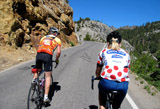Pre-race Preparation
Related: Everest Challenge, hard core, Rides, training
This page covers various items on what you should be doing the week prior to the Everest Challenge. Some of it might apply in general to any such endurance event.
Rides prior to the race
I do not recommend attempting the Everest Challenge without at least two full prior days in the area doing a few easier ascents to the 10,000 foot level.
Taper the last day with a 2000 foot ascent or so, so that you’re well rested for the race, and don’t exceed 3000 vertical ascent per day on prior days rides; you want to be very well rested, and it won’t help you to engage in major efforts the prior week— there is no fitness to be gained. Mainly your body needs to adapt to the altitude, and repair any deferred muscle damage from months of training.
Hydration
The dry air of the eastern Sierra sucks moisture out incredibly fast. If you don’t stay hydrated in the days prior to the race, then your chances of finishing diminish considerably. Drink plenty of fluids, with electrolytes.
Altitude
Most of the Everest Challenge stage race ascents top out near 10,400 feet of elevation. While anyone in suitable condition to attempt the race will have no real issue with the elevation, allowing several days to adjust to altitude is worthwhile. But by allowing 0 or 1 days to acclimate, even the most fit athletes will show impaired performance.
In theory, full acclimatizing to high altitude could take up to two weeks. In practice, I find that spending 2-3 days prior to the race at the 10,000 - 11,000 foot level eliminates 90% of the thin-air challenge.
For my 2004 attempt, I slept at about 11,000 feet for 3 nights prior to the race, and I believe this forced my body to adaptations prior to the race. Not full adaptation, but enough that it was no problem at all when I hit the 10,000 foot level during the race.
For the 2011 attempt, I allowed five nights and days at altitudes between 9,000 and 11,000 feet. I felt unusually tired the first 3 days, but by the race, I could feel that my body had made major progress in adapting to the 10,000+ elevation demands. Thus, I recommend a full five-day adjustment period for serious athletes.
My other experience backpacking and hiking confirms this; I need 2-3 days to feel fully at home at the 10,000 foot level. As a counterpoint, I’ve ascended to the summit of Mt Whitney(14,494') from sea level in less than 24 hours, but this definitely did not feel so great at the summit.




